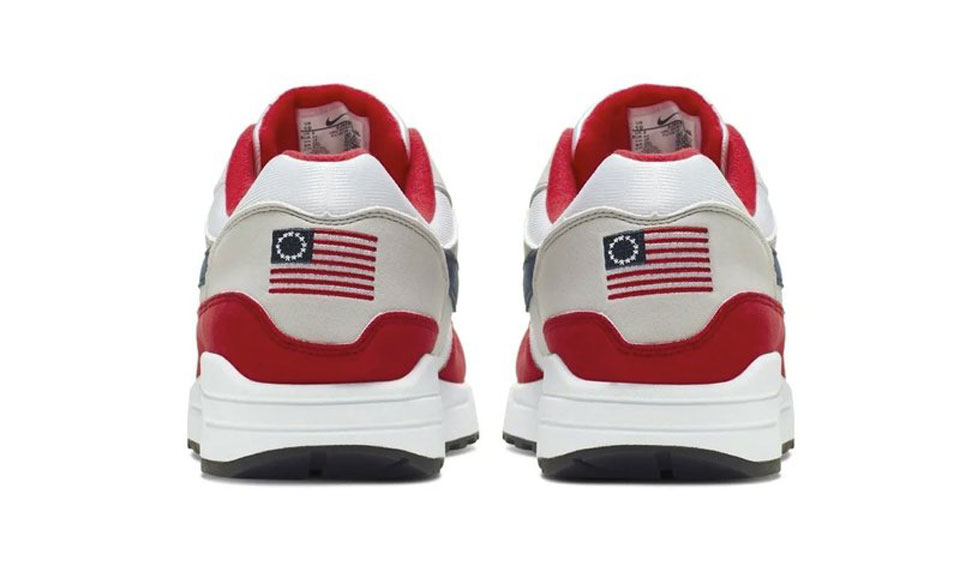
NEW YORK (AP)—Nike’s sales have only grown since it seized attention with its ad campaign featuring former NFL quarterback Colin Kaepernick. So, the shoemaker deferred to its star endorser when he raised concerns over a sneaker featuring an early American flag.
Nike pulled the Air Max 1 USA shoe, which included a Revolutionary-era U.S. flag with 13 white stars in a circle on the heel. Kaepernick reached out to Nike after learning they planned to release the sneaker to explain that the flag recalls an era when Black people were enslaved and that it has been appropriated by white nationalist groups, a person familiar with the conversation told The Associated Press.
The person requested not to be named because the conversation was intended to be private.
Nike decided to recall the shoe after it had already been sent to retailers to go on sale this week for the July Fourth holiday, according to the Wall Street Journal.
The decision caused an instant backlash among conservatives who accused Nike of denigrating U.S. history, with Arizona Gov. Doug Ducey tweeting that he is asking the state’s Commerce Authority to withdraw financial incentives promised to Nike to build a plant in the state.
Others expressed surprise that the symbol known as the “Betsy Ross” flag, so named after the Philadelphia woman credited with designing it, could be considered offensive. Although some extremist groups appear to have appropriated the flag, it is not widely viewed as a symbol of hate and is used in museums that focus on 18th century U.S. history.
The Anti-Defamation League does not include it in its database of hate symbols. Mark Pitcavage, a senior research fellow for the ADL’s Center on Extremism, said extremist groups have occasionally used it, but the flag is most commonly used by people for patriotic purposes.
“We view it as essentially an innocuous historical flag,” Pitcavage said. “It’s not a thing in the white supremacist movement.”
Nike said in a statement that “it pulled the shoe based on concerns that it could unintentionally offend and detract from the nation’s patriotic holiday.”
Kaepernick was the first NFL athlete to take a knee during the national anthem to protest police brutality. Some people called for boycotts after Nike featured him in a campaign last year that included a print ad featuring a close-up of his face and the words, “Believe in something. Even if it means sacrificing everything.”
The boycott calls fizzled.
Nike’s annual sales have jumped 7% to more than $39 billion, according to the company’s last quarterly report. Its stock is up 12% since the start of the year.
Gov. Ducey, meanwhile, ordered Arizona to withdraw a grant of up to $1 million that was slated for Nike. But the governor has no authority over more than $2 million in tax breaks over five years that were approved Monday by the City Council in the Phoenix suburb of Goodyear, where Nike committed to opening a $185 million factory that would employ more than 500 people.
Nike is unlikely to suffer financially over the flag flap, said Matt Powell, a sports industry analyst at NPD Group Inc.

“I’m sure there are plenty of states out there that would love to have a Nike factory that would employ 500 people,” Powell said.
The abandoned shoe sparked a discussion on social media and beyond about the Betsy Ross flag itself.
In 2016, a Michigan chapter of the NAACP said the flag has been “appropriated by the so-called ‘Patriot Movement’ and other militia groups who are responding to America’s increasing diversity with opposition and racial supremacy.” The statement came in response to a high school football event where the NAACP said some white students used the flag while attempting to intimidate players from a predominantly black school.
The Anti-Defamation League says “Patriot movement” describes groups that include militias and others who have adopted anti-government conspiracy theories. The ADL says there is some overlap between the “Patriot” movement and the white supremacist movement, but that overlap has shrunk over time.
Lisa Moulder, director of the Betsy Ross House in Philadephia, said she has never heard of the flag being used as a hate symbol.
“Personally, I’ve always seen it as a representation of early America,” Moulder said. “The young nation was not perfect, and it is still not perfect.”
Associated Press writers Michael Kunzelman in College Park, Maryland, Jonathan Cooper in Phoenix, and Summer Ballentine in Jefferson City, Missouri contributed to this story.










